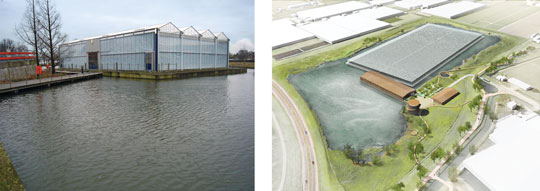2/21/2011
Whatever Floats Your Flowers
Chris Beytes
We’ve heard of parade floats covered with millions of flowers … but growing those flowers in an actual floating
greenhouse? In the Netherlands, they’re giving it a serious try. Why? To make double use of land.
In the Netherlands, 25% of the land (and 21% of the population) is below sea level. Flooding is a perpetual issue, and when that happens the water management folks like to direct excess water into temporary holding areas (polders), so occupied land and river areas aren’t flooded. But maintaining empty polders only for flood alleviation is a waste of valuable land. That’s where the idea of double usage comes in, and one idea is floating
greenhouses.
“
Greenhouses are an ideal solution,” says Johan van der Pol, the adjunct-director of Dura Vermeer Business Development BV, the lead partner in the development of the demonstration
greenhouse pictured, “because one
greenhouse covers several hectares, it is relatively light and of uniform weight, and it is often placed in areas that are laying quite low.”

To that end, in 2005, Johan and his team at Dura Vermeer built the Demo Floating
Greenhouse (pictured) at the Naaldwijk location of FloraHolland (the Dutch flower auction) to study the theory and challenges of creating a floating
greenhouse. The foundation must be rigid enough to prevent excess flex (that is a glass
greenhouse, after all). And all the utilities—electrical, fuel, water—must be attached with flexible umbilicals for the occasion when the land beneath needs to be flooded and the
greenhouse needs to rise. The Demo Floating
Greenhouse has been successfully bobbing in a pond at the auction for the six years since (it’s being used as an event center).
Shortly after construction, Johan and partner Unidek started a joint venture called FlexBase (
www.flexbase.eu) to develop floating foundations for various types of buildings made from polystyrene and reinforced concrete.
Around the time of the debut of the Demo house, the province of South Holland initiated a 5-hectare (535,000-sq. ft.) floating
greenhouse project called “Floating Roses World.” On February 10, Johan’s team presented a preliminary year-long investigation to the province. They hope to start construction in 2012. In addition to this proposed project, Johan says they’ve been contacted about several other floating
greenhouse initiatives, primarily in Asia.
Interestingly, the floating part isn’t hard. It’s the politics.
“The biggest obstacle of all is valuing water storage capacity,” says Johan. “That’s the big thing … who values the water and is willing to pay for the facility?”
GT